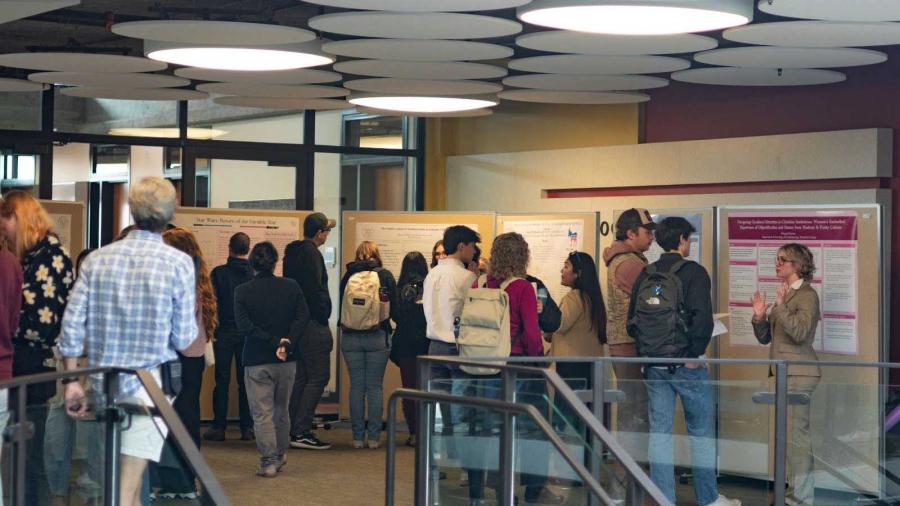Westmont News
Student Research Symposium Where Curiosity Meets Discovery

By
Scott Craig
Nearly 50 students participated in the 29th annual Student Research Symposium presenting their scholarly research in April. The 34 projects spanned the humanities, social sciences and natural and behavioral sciences. Topics included sports anxiety and athlete burnout, stress in spiny lizards, analysis of a reusable launch vehicle, and the ortho-arylation of aryl carbonates.

“It’s important to celebrate the noteworthy accomplishments of our students,” said Kim Denu, provost and dean of the faculty. “The opportunity for undergraduates to collaborate closely with faculty on research and scholarly endeavors represents a defining feature of Westmont’s academic experience.”
Gewnhi Park, associate professor of psychology, conducted seven research projects with students while Meredith Whitnah, associate professor of sociology, conducted six. Benjamin Mandani ’27 and Berit Lunstad ’26 worked with Jennifer Ito, assistant professor of physics, on the Keck Telescope for their project, “Call Me Variable: Stars That Just Can’t Commit.” Their research shows the surprising possibility that their variable star is a three-body system.
“Stars are spherical harmonic resonance structures, so they can pulsate radially — getting bigger and smaller,” Mandani says. “But our star may be a multi-modal resonant star, meaning it may be three stellar bodies opening about each other in an irregular fashion.”
“I wasn’t expecting the trial and error involved,” says Lunstad, who plans to pursuit a doctorate in astrophysics or particle physics. “I always thought scientists had a much better idea of what they would find.”
With more late nights using data from photometry, they hope to send their findings to the American Association of Variable Star Observers.
Kennedy Burkett ’26 worked with Ronald See, professor of psychology, for her project, “Effects of Binaural Auditory Stimulation on Sleep Latency.” She tested the impact of 147 Hz and 149 Hz binaural beats on sleep with a device that measures brain waves and distributes audio into the temporal lobe. Despite various sleep environments and durations, Burkett found no significant difference.
“I wore it when I slept during the summer,” she says. “Half the nights, I did the delta wave track, and a lower band of white noise for the other half. Unfortunately, I discovered no difference — but I found it hard to sleep with the uncomfortable device.”
The research team of Lauren Ahmann ’25, Ellie Muench ’25, Alexandra Pilch ’25, Dusty Schraeder ’25 and Elizabeth Vousboukis ’25 worked with Jada Willis, associate professor of kinesiology, on “Faith, Fertility and knowledge: Evaluating Reproductive Health Awareness Among Young Adults.” Inspired by declining fertility rates and a perceived lack of advancements in women’s health research, the study included 500 participants answering a validated questionnaire. “Preliminary findings suggest that even those assumed to have high knowledge may have gaps, particularly regarding menstruation,” Ahmann said.
The same group also displayed the results of another project, “Optimizing Athletic Performance: Implementing a Sports Nutrition and Performance Program at a Private NCAA Division II Institution,” which compared Westmont student-athletes’ knowledge of sports nutrition to that of regular students. A questionnaire that included knowledge of nutrition and demographic information assessed the need for a fueling station at Westmont. “Studentathletes here don’t know enough about their nutritional needs,” Pilch says. “If they did, they could possibly perform better.” She also suggests an off-hours meal station where student-athletes can refuel before workouts or games.
Nearly 30 students presented their summer findings on 19 different research projects representing the natural and behavioral sciences division (biology, chemistry, engineering, physics and psychology) on Oct. 4 in Winter Hall. Many of them worked as paid, full-time research assistants, collaborating with professors on cutting-edge projects that sometimes extends into the school year.